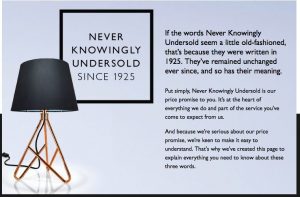How can your organisation stand out in the market?
What is brand positioning?
In a noisy, bustling market it is important for your organisation to stand out from the crowd. Brand positioning, also known as positioning strategy or brand strategy, is vital for lasting success.
Brand positioning is a concept that defines a lot of companies marketing strategies. It’s a process in which a brand, through consistent and well-thought-out strategy, occupies a distinctive place in the market. By communicating how your brand is different from (and better than) your competitors, you are able to position your brand in the mind of your target audience.
Being ‘different’ could mean a whole host of things, depending on what you think your brand stands for as well as what will appeal to your target audience most.
Why do I need brand positioning?
Look at some of the most successful companies in the world. What do they have in common? They all have strong branding. When you think about going on holiday, you might think about booking a hotel or an Airbnb. When you think of ordering a taxi, you might think of getting an Uber instead. When you think of sportswear, do you think of Nike or Adidas? Computers – Microsoft or Apple?
These brands have all found niches in the market and have asserted themselves in those spaces. Airbnb, for example, provides holidaymakers with a home away from home. A more personal, comfortable, and private vacation experience.

AirBnB knows a lot of their customers have pets. This has helped them find a niche in the market, because their main competitors, hotels, often don’t allow pets.
Microsoft has brought the personal computer to the general consumer. Microsoft’s range of hardware and software has made owning a computer extremely easy and affordable. Microsoft’s operating system has a particular appeal for businesses. On the other hand, Apple has created sleek products that represent creativity, innovation, and ‘the future’. Apple’s branding reflects the consumer’s desires. The idea is that if you own an Apple product, you are creative, innovative, and forward-thinking – just like Apple.

“Your life in your pocket.” This brand messaging is all about the customer. A way to position Apple as a convenient and useful device, that makes the customer feel ‘ultimate’ too.
By positioning your brand correctly you occupy an area of the market rather than just blending in with the rest of the crowd. If you don’t have a brand positioning strategy, you risk becoming a clone – a brand that looks the same, talks the same and does the same as all the other clone brands.
And by becoming a clone brand you risk your target audience never knowing what you stand for, or what service/product you deliver. They might not even know who you are if your competitors occupy a stronger and more distinct position in the market.
How to effectively position your brand
Before we examine the different ways in which you can position your brand in the market, you need to ask yourself these 3 questions. Try to be objective and honest in your answers.
1) Who are my target audience? (Consider their age, gender, industry, job title, problems, goals)
2) What are my brand’s unique selling points?
3) How does my business compare to my competitors?
Answering these 3 questions will help guide your brand positioning strategy. Your branding should appeal to your target audience. Apply this well-known quote from Steve Jobs to your brand positioning.
“You’ve got to start with the customer experience and work backward to the technology. You can’t start with the technology and try to figure out where you’re going to sell it.”
Steve Jobs, who was customer experience-centric, is right. When applied to branding, you need to know who your customer is. You need to know what will appeal to your customer. You then need to structure a customer-centric branding strategy.
So let’s take a look at some various branding options that appeal to your customer’s needs.
Service brand positioning
In this strategy, you’re focussing on the quality of service you deliver. It could be friendly staff, quick replies, customer satisfaction rates, or strong customer support. But bear in mind that if you don’t like up to the high standards you’re setting, be prepared for backlash.
Price-based brand positioning
In this strategy, you’re focussing on providing customers with the most affordable option. You might not offer the best, most comprehensive service or product… but not everyone wants that. Some people just want something that will do the job, for cheap. It’s even better if your brand can provide something that’s cheaper than competitors but is just as good. So bear in mind that being affordable is often associated with lower quality. You may put off the high-spenders.

John Lewis took a balanced approach, providing quality products at a competitive price.
Quality assurance brand strategy
Sometimes, your product or service is simply better than your competitors. In this strategy, you’re demonstrating the high quality of your product, backed up by satisfaction guarantees (e.g. Not satisfied? Get your money back). This could include high-quality production and guaranteed results, for a premium price. Think of premium car brands, like Rolls Royce. But you’ll need to prove your brand is worth investing in. Back up your statements with testimonials, imagery, videos, and case studies.
Convenience brand strategy
In this strategy, you’re highlighting just how easy your product or service is to use. Perhaps you deliver straight to your customer’s door? Perhaps it’s a simplified subscription structure (think Netflix, Audible, Amazon Prime) that is easy to understand. Choosing your brand will save your customers time and stress, because your product/service is so easy to use, and it still gets results. Plus, your customers may think it’s worth paying a little bit extra for something that is convenient and suits their needs. However, you have to think of the infrastructure and costings of being convenient. It requires a lot of work on your end, but happy customers will stay customers for longer.
Differentiation brand strategy
Find a niche in the market and own it. In this strategy, you’re pinning your colours to the mast. You’re not trying to cater to everyone. Instead, you’re offering a product that is unique and a little niche. In the automotive industry, there are dozens of brands that provide a range of cars. Diesel, petrol, hybrids, and e-cars. Tesla provides electric vehicles. That’s it. They’ve chosen that niche, but they do it well. They provide high-quality, high-cost electric vehicles that are better than their competitor’s e-vehicles.

Tesla has designed a car that appeals to customers who are thinking about their carbon footprint. That way, customers can experience luxury whilst also doing a good thing for the environment.
Alternatively, your branding could be based around a demographic niche. Perhaps your product is designed for a specific person. Vegans. Environmentalists. Men or women. The LGBTQ+ community. People who commute daily. People who can’t sleep. The list goes on. Focus on a demographic. These things make you different from your competition and will make you more memorable for your target audience. Bear in mind that you can narrow your audience too much. If your product and branding are obscure you might struggle to get the return on investment. Finding the sweet spot between niche and obscure is fundamental.
Alternatively…
Alternatively, your brand might be selling something that is the first of its kind or doesn’t have much competition. This comes with positives and negatives. The positives, are of course, that you can position yourself as a pioneer and innovator. This gives you strength in the market, should competition arise later. However, being an innovator also means you’re going to have to work extra hard to be visible and create demand. You’re going to have to convince people that they need your product.
Things to consider
Avoid being a clone
To ensure your brand doesn’t become another clone brand that gets lost in the oversaturated market, you’re going to have to conduct competitor research. Find out who your real competitors are.
For example, Ford and Lamborghini are very different car companies. They’re not competitors, and they don’t pretend to be. However, Volkswagen and Ford are competitors. Both companies will be looking to brand themselves differently, whilst appealing to the same target audience.
So, assess your competitors at a local and national scale, and determine how you can find your niche and position your brand in the market.
Lifestyle
In today’s market, there is a growing trend in which customers want to feel like they’re a part of something larger. They don’t want to be a consumer. They want to be someone that contributes to society, and shops at brands that reflect their values. This trend can be seen in adverts, on social media, and in the news.
This is why brands are aligning themselves with celebrities, personalities, and influencers, or movements like Black Lives Matter. Brands want to be seen as more than their brand, for example socially or environmentally responsible. This helps them appeal to certain audiences. Plus, in doing so, they are contributing to (subjectively) positive change.
Think about what kind of lifestyle your audience wants to live. Are you contributing to that lifestyle in almost everything you do?
Let’s examine Salcombe Gin. Their branding is oriented around yachts, the seaside, luxury, exotic. When you buy a bottle of gin, you are buying into that lifestyle… and even if you don’t own a boat or live by the sea, Salcombe Gin are selling you the lifestyle.

Salcombe Gin’s stylish boathouse bar reflects Salcombe Gin’s brand strategy. Luxury. Tradition. Stylish. If their bar looks this good, the gin must taste good too!
Can you say the same about your brand? What lifestyle does your target audience want, and does your brand help them work towards it?
To Conclude
Brand positioning isn’t something that happens overnight. It’s a strategy. A process.
Successful brand positioning is achieved by consistent and purposeful action. Keep your brand messaging consistent across your channels and don’t try to cover every niche. So, even if you have more than three unique selling points, it will be hard to communicate all of them effectively. By focussing your messaging, it will make your branding stronger and more consistent.
How can Hedgerow Marketing help?
We can help your business position itself in the market by using effective strategy and marketing techniques that will help you stand out from the crowd. For more information on our services, please visit our page here.
Contact us here:




